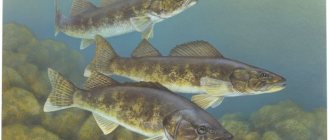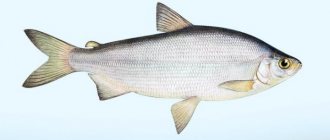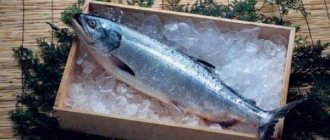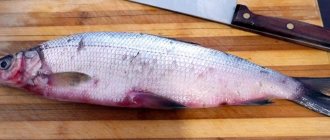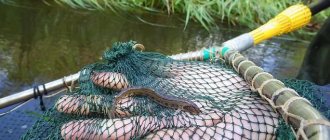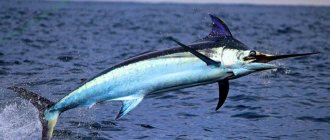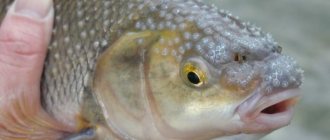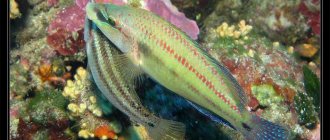Description
Whitefish Whitefish
(lat. Coregonus) is a genus of commercial fish of the salmon family. More than 40 difficult-to-distinguish species of whitefish are found in the rivers and lakes of Europe, northern Asia and America. Main species: anadromous whitefish (Coregonus lavaretus) with many varieties: ludoga whitefish (Coregonus fera), goat whitefish (Coregonus widegreni) and others. Vendace belongs to the same genus. In Siberia the following are common: omul, polkur, muksun and shokur (chir).
Whitefish
is an extremely polymorphic species, so it is difficult to identify characteristic features of the species. It belongs to the group of whitefishes with a lower mouth, although the position of the mouth can vary from typically lower to almost terminal. There is often a well-defined snout area, the height of which is less than its width. The body is silver with a dark back, the fins can be dark, sometimes even black. The nuptial plumage in the form of epithelial tubercles is more pronounced in males.
More than 40 subspecies have been described for the species, but recently their number in Russia has been reduced to 6:
- Coregonus lavaretus baeri Kessler, 1864 - Volkhov whitefish,
- Coregonus lavaretus baunti (Muchomedijarov, 1948) - Baunt whitefish (spring spawning),
- Coregonus lavaretus lavaretus (Linnaeus, 1758) - European whitefish,
- Coregonus lavaretus maraenoides (Poljakow, 1874) - Chud whitefish,
- Coregonus lavaretus pallasi (Valenciennes, 1848) - polystamen whitefish,
- Coregonus lavaretus pidschian (Gmelin, 1788) - whitefish, or Siberian whitefish.
Often the diversity of whitefish is further complicated by the fact that in one body of water, whitefish are represented by several forms, differing in the number of gill rakers, feeding spectrum and spawning sites; in large reservoirs (Ladoga, Onega, Imandra) the number of such forms can reach 4-9. Let us note as an example of parallel variability the appearance of a cartilaginous and elongated snout in genetically heterogeneous and geographically separated forms of whitefish (whitefish in Anadyr and the same in the Baltic), the formation of tall-bodied or humpbacked whitefish (Baltic, Kola Peninsula, Yakutia, Anadyr) or, conversely, the formation of oblong and elongated forms in river and lake-river whitefish (Baltic, Karelia, Siberia). For a description of the various morphological forms of whitefish, see below.
As mentioned above, this species is distinguished by a wide variety of ecological forms. These are migratory, river and lake whitefish; in large lakes they, in turn, are divided into coastal, deep-sea and pelagic with different feeding patterns - from typical planktivores to typical benthophages, occasionally whitefish are predatory and eat the eggs of other species and their own.
Description of whitefish
Coregonus or whitefish is a genus of the family Salmonidae (salmon). Some scientists place it in a separate whitefish family, along with nelma and whitefish. The whitefish is distinguished by its compressed body, covered with medium-sized scales, and a medium-sized mouth that does not have teeth on the vomer and maxillary bones. The teeth in other parts of the oral cavity are either extremely poorly developed or disappear over time.
Another distinctive feature of the whitefish is that its upper jaw bone does not extend beyond the eye. Common characteristics of whitefish also include the fact that the position of the mouth often changes - from almost terminal to typically inferior, depending on the species and shape. You can also trace the presence of a snout platform, the height of which is less than its width.
In size, whitefish are relatively small, with a standard length reaching up to half a meter (usually 40...50 cm) with an average weight of 700...800 g. However, the most powerful forms of whitefish are also found - weighing approximately 1000 g with a body length of 50...60 cm . There are also whitefish weighing from 3000 g to 5000 g.
Almost all representatives of whitefish have a light color - silver-white or silver-gray sides against a darkish back , giving off olive-brown, green or lilac tones, and a milky-light or slightly grayish belly. The fins, on the contrary, are darker and can even be black. The intensity of this color varies slightly in each variety and form. Whitefish do not have spots on their fins or body. This is accurately reflected in its name in English - “white fish”, which translates as “white fish”.
Distribution and habitats
The migratory whitefish has a circumpolar distribution. In Russia, it inhabits almost all water bodies of the Arctic Ocean basin, from the Barents and White Seas to Chukotka, it is found in the Penzhina and Anadyr rivers, but not in Amguem: it is also found in the Baltic Sea basin (Curonian and Finnish gulfs, reservoirs of Karelia). The Bauntovsky lakes (Transbaikalia) are home to a unique spring-spawning whitefish, which is classified as a special subspecies Coregonus lavaretus baunti. On the American continent, whitefish are recorded in the waters of Alaska and Canada; a closely related form, Coregonus clupeaformis (Mitchill, 1818), is found in many water bodies of North America.
Distribution and habitats of whitefish
Whitefish loves clear and oxygen-rich water. Stays in the water column. Depending on their size, whitefish lead a different lifestyle - smaller ones (weighing up to 500 g) stay close to the shore all year round, large whitefish (weighing from 1.5 to 6 kg) prefer to be in holes and under riffles next to fast streams . In the morning and evening, large whitefish come closer to the shore. Interestingly, the whitefish has a habit of surviving other fish from the hole it likes.
Kinds
In total, there are more than 50 whitefish subspecies, which are found in rivers, lakes and seas of various countries. Absolutely all whitefish can interbreed with each other, forming even more new subspecies. That is why it is impossible to say exactly how many species of everything exist in nature. For each subspecies, external characteristics may vary due to climate, temperature and location where the whitefish lives. Sizes can vary depending on what and how often the whitefish eats. Consider a list of the most recognizable fish species with photographs and more detailed descriptions.
Chudsky
The white sandpiper, the so-called Chud species of fish, lives in Pskov, Chud, Onega and other lakes located in the Urals. Standard dimensions are 60 centimeters in length and weight approximately 4 kilograms. The subspecies has a small head on which an asymmetrical jaw is located. The upper part of the mouth is slightly longer than the lower. The head ends with a rounded wide nose. The Chud subspecies has several differences from the appearance of the migratory individual:
- The back of this species is thicker and smoother, this is due to the fact that the fish does not have to travel long distances and exert great physical effort.
- The head of the Chud whitefish is more elongated.
- The fish has rounder and more voluminous eyes, so the look of the aquatic inhabitant is a little timid.
- The scales on the back of the fish are green with a brownish tint. The sides of the body are colored silver, and the color of the abdomen is close to white. All fins are gray, and not black as in anadromous species.
The number of Chud whitefish is increasing only through artificial fish farming. Therefore, mass catches of this species are officially prohibited.
Baltic
This form of whitefish is found in the bays of the Baltic Sea and inhabits many lakes in its basin. Also, the Baltic subspecies lives in lakes in Great Britain, Denmark, Germany, Austria, Switzerland, Poland, Russia, Sweden and Finland.
The body of the Baltic individual is elongated, similar to the body of a herring. Like all whitefish, the Baltic has an asymmetrical mouth. The color of the back, head and fins is dark, and the color of the belly and sides is light. It feeds all year round, consuming mainly mollusks, chironomid larvae and benthic crustaceans.
Ordinary
This subspecies is most often found in Russian reservoirs. He leads both a passing and permanent lifestyle. Found in many rivers, lakes and even seas. Valuable lake fishing trophies do not reach enormous sizes. When caught, it resists strongly and tries to jump off the hook. This resistance and thirst for life is highly valued by sport fishing enthusiasts.
This whitefish has more than twenty intraspecific varieties. They hardly differ from each other, therefore they are not yet recognized as independent. The body of this species is low, its height is 1/3 of the body length. The color of the fish is the most classic: silver body, dark back. From April to November, individuals lead a predominantly migratory lifestyle. The most intensive movements occur from September to October. The fish leave for spawning at the end of October or beginning of November. For spawning, the female looks for sandy soil. The juveniles of the normal species that survive from the litter live in rivers for up to two years, and then move to the sea.
Siberian
The Siberian species, best known under the name pyzhyan, is a semi-anadromous fish from the order whitefish. Lives at the bottom of large rivers in freshwater and salty bays. It is found in the Arctic Ocean basin, in the western part of the Bering Sea, as well as in the Barents and White Seas.
Characteristic signs of the pyzhyan:
- a small number of gill rakers;
- shortened lower jaw;
- high caudal peduncle.
This species does not grow very quickly; puberty occurs only in the fifth or even 9th year of life. The diet includes: chironomid larvae, mayflies, caddis flies, small mollusks, sea cockroaches and gammarids. It is extremely rare that Siberian fish can snack on the young of other aquatic inhabitants. At spawning grounds it eats the eggs of its own kind. More than half of the whitefish catch worldwide comes from this species.
Lifestyle
Whitefish lifestyle Whitefish loves clear and oxygen-rich water.
Stays in the water column. Depending on their size, whitefish lead a different lifestyle - smaller ones (weighing up to 500 g) stay close to the shore all year round, large whitefish (weighing from 1.5 to 6 kg) prefer to be in holes and under riffles next to fast streams . In the morning and evening, large whitefish come closer to the shore. Interestingly, the whitefish has a habit of surviving other fish from the hole it likes. It feeds throughout the year, including in winter. The main food for whitefish with sparse gill rakers is bottom organisms, since whitefish of these species are not able to filter plankton. Adult whitefish can also eat fish. According to observations, whitefish eat fish eggs, and even their own.
Sexual maturity of fish occurs at 2-3 years of age. Whitefish spawning on the Kola Peninsula and in other places occurs in late autumn. The fish lays eggs on the fairways of rivers. Whitefish spawn in September-December. Spawning occurs on pebble bottoms or on reefs, often in standing water. Females do not lay eggs. Whitefish spawn in holes in the river fairway. With the onset of cold weather, whitefish go to their favorite pits for the winter. Females lay eggs on coarse sand or on stones at shallow depths near the shores; lake whitefish species lay eggs on pebble areas of the bottom. The eggs lie on the bottom throughout the winter, the fry are born only after the spring ice melts, when the water warms up enough and there is enough food for the young
Whitefish are recognized as a valuable fish species and are the object of fishing in various zones of the North. Today, whitefish are successfully bred in the reservoirs of the Southern Urals. Whitefish is a fish with exceptionally tasty meat. Smoked whitefish is especially prized. But all representatives of whitefish are also suitable for other types of culinary processing. Whitefish can be boiled with herbs, fried in oil, stewed with or without sauce, or baked in the oven. Gutted whitefish carcasses can be stuffed with mushrooms or cereals and baked in foil.
Whitefish family: variety of forms
The whitefish family includes more than forty different species of fish. Migratory whitefish is considered widespread. The family itself is distinguished by a variety of forms, which is sometimes regarded as the presence of independent species. These include sand, Neva, river, sea whitefish, as well as Valaamka. These representatives of the whitefish family can be found in areas of North America, Europe and Asia. At the same time, the largest of them are found in North America and can weigh up to 10 kg.
general information
The whitefish family is characterized by a long, laterally compressed body, a small head and relatively large eyes, as well as a small mouth. The sides of the fish’s body have a silvery color, and the back can shimmer with a bluish-gray-green hue. As a rule, the sizes of individual individuals reach quite large values, with a weight of more than 10 kg. Lake whitefish have approximately the same characteristics. Fish meat has excellent taste and is a traditional element of northern cuisine. The meat of this fish helps the peoples of the north survive in such difficult natural conditions.
Habitat
This predator feels great only in perfectly clean and cold water. Small individuals prefer to be in the coastal zone, near channels and in places where there are steep drops in depth. Larger specimens choose places that are closer to the river fairway, next to rifts, where there are deep holes, as well as areas where there is a border between fast and slow currents. Whitefish gets along well with grayling and perch. Moreover, this is typical for those areas where the habitat horizons of these fish do not intersect. Otherwise, the whitefish will easily deal with those who want to occupy its territory.
Lifestyle
The way of life of these inhabitants of the deep sea depends on their size. Small individuals prefer to stay close to the coast. Larger individuals prefer deep places with fast flows of water. Early in the morning or late in the evening, whitefish can be found in shallow water.
Interesting! Sig waits for his prey while in a hole.
The fish feeds throughout the 12 months, including the winter months. The main source of food for whitefish are bottom microorganisms. Whitefish do not filter plankton like other fish species do.
In this regard, the diet of whitefish includes small specimens of other fish species. Some scientists claim that whitefish do not mind tasting the eggs of other fish species, including their fellows.
After 3 years of life, the period of puberty begins. During this period, the fish lays eggs on the river fairway. At the same time, whitefish spawn from September to December. Moreover, females do not cover their eggs. As soon as the cold weather begins to set in, the whitefish goes to look for warmer waters. Such places may be deep holes that are known to the fish and where they have been before. After the spawning process, the eggs remain in this state until spring, when the last snow begins to melt and turn into cold river water. During this period, the first fry of this amazing fish appear. At this point, sufficient heat and the required amount of feed are provided.
Whitefish fishing
Whitefish fishing Commercial fishing of whitefish is carried out mainly with nets and in reservoirs specially designated for its breeding.
A license is required for recreational and sport fishing of whitefish; in addition, a limit is set for the catch of whitefish of any type. Whitefish is an interesting object of sport fishing. The main reason for this is that whitefish meat is very tasty and tender. In addition, it is extremely useful: it contains fats, proteins, substances such as molybdenum, chlorine, nickel, fluorine, zinc, chromium, and vitamins. Whitefish meat is white, despite the fact that it is a salmon (red fish). As you know, any fish that lives in cold northern waters has a high fat content. Sig was no exception. Its fat contains a high concentration of vitamin A (good vision), vitamin D (strong bones).
They fish for whitefish in the summer, when the fish “walks” along the river in search of food. You need to look for it in holes with reverse currents, on rifts in sunny weather. Whitefish fry are found on high banks, where they flock together in schools and stand under the shore. Larger individuals prefer deeper places.
In a pond, whitefish are quite aggressive and often displace any other fish from their habitat. This property can also be used for fishing. Thus, in the spring, whitefish are often found in places where fry and any small schooling fish gather.
In winter, whitefish stand in pits and winter fishing for whitefish comes down to searching for such pits. The most catchy period of winter whitefish fishing is considered to be the period of last ice, i.e. in the spring. In this respect, whitefish is very similar to its brother, grayling. With the onset of spring warming, when the water begins to be enriched with oxygen, whitefish begin to feed very actively, fattening up the fat lost over the winter.
They catch whitefish using any tackle: from a float rod to a fly rod. Whitefish are not cautious fish, so no special precautions are required when fishing.
Whitefish, due to its fat content, is a perishable fish (again, like grayling), so immediately after catching it must either be eaten or salted (smoked).
